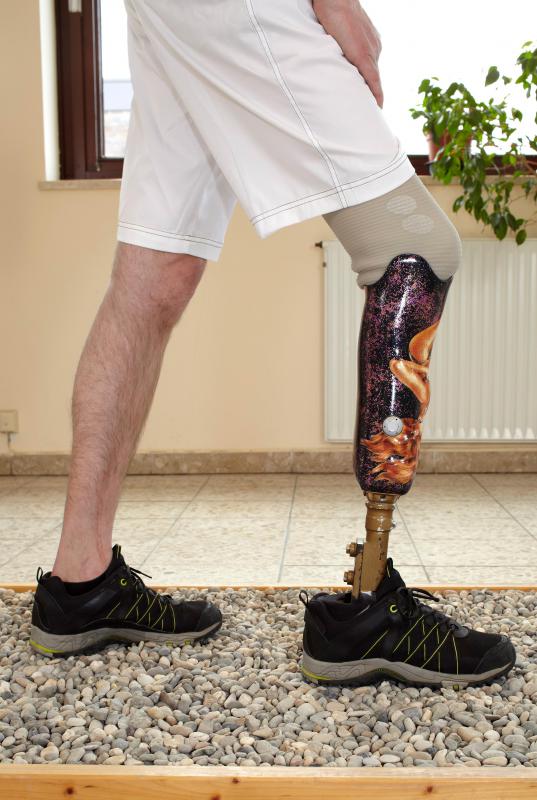At WiseGEEK, we're committed to delivering accurate, trustworthy information. Our expert-authored content is rigorously fact-checked and sourced from credible authorities. Discover how we uphold the highest standards in providing you with reliable knowledge.
What are Prosthetic Devices?
Prosthetic devices are artificial components designed to replace a part of the human body that is missing, either due to accident or a birth defect. When discussing prosthetics, many people think only of artificial arms and legs. However, there are other types of prosthetics that are in common use, such as dentures.
The exact origin of prosthetic devices is not known. There are evidences dating back to ancient Egypt of hands, arms and feet being fashioned to take the place of limbs lost during war or due to accident. In some cases, the prosthetic devices were mainly aimed at providing function and did not bear much resemblance to the body part they replaced. However, other devices were created that focused more on appearance and less on function.

In modern times, prosthetic devices come in many different forms. Dentures were once prepared using wood and other products. While functional, they did not necessarily provide the appearance of a set of healthy teeth. Today, partial and full denture plates are often indistinguishable from real teeth. Advances in technology have also made it possible to design custom dentures for a more comfortable fit as well as a superior appearance.

The progress of artificial limbs can be seen over the centuries. From a simple wooden peg to the intuitive prosthetic legs of today, technology has made wearing and operating prosthetics of this type much easier. Artificial legs today can allow the individual to achieve perfect balance when walking or even running. Biosensors built into many of the devices make it easier to control the movements of the legs, including tasks such as sitting down, rising out of a chair, or climbing.

Prostheses for the feet have also advanced over the last century. At one point, a prosthetic foot provided little more than a means of allowing the individual to wear two shoes and walk with the aid of a cane. Modern innovations provide a range of motion for the foot that is very similar to that of a natural foot. The increased functionality also means that many people who wear an artificial foot do not have to depend on a cane or other walking device to move around.

The prosthetic limb selections of today no longer make it necessary to choose between function and appearance. Many artificial arms and legs can be covered with synthetic materials that mimic the look and feel of skin and musculature. While it is still possible to tell the difference between prosthetic devices and natural limbs, the task usually takes closer observation in order to recognize the distinction. This combination of practical function and more pleasant appearance can make it possible to participate in many activities that the amputee would otherwise avoid.

Not all prosthetics are found on the outside of the body. Artificial hearts and lungs also qualify as prostheses, making it possible for people who otherwise would not be able to continue living enjoy at least a few more years. Gastric bands are also identified as prosthetic devices, and can aid many people in their pursuit of better health.
Prosthetics have advanced a great deal since the middle of the 20th century. As more enhancements are developed, the devices are likely to provide assistance to even more people, as both the range and the quality of the devices continue to broaden.
AS FEATURED ON:
AS FEATURED ON:
















Discussion Comments
@Ana1234 - I wish more of that care was seen today. Unfortunately we've got more need for artificial limb specialists than ever, because we've reached a point in war technology where the average weapon isn't capable of getting through the average soldier's armor.
So they aren't killed outright, but their limbs are often badly damaged and they end up losing them. That's better than losing their lives, but best of all would be if neither had to be true.
On the other hand, I've heard some very encouraging things recently about the role 3D printers might be able to play in making custom prosthetic devices, so hopefully that will start to open them up for more people who otherwise couldn't afford them.
@irontoenail - The history of prosthetic devices must be fairly interesting, because they wouldn't come into being until you had a society capable of not only help and caring for people who needed a prosthetic, but also had the time and expertise to make one.
So if you find a culture where prosthetic devices exist, it says something about how they care for their sick and elderly.
One of the most amazing ancient prosthetic devices I've ever heard of was found with a woman who lived thousands of years ago. When they discovered her tomb she was found with an artificial eye coated with gold in one of her eye sockets. The eye was designed with a pattern on the surface and had little holes so that it could be held in place by thread.
The woman was also quite tall for the age, and I can just imagine this awesome, statuesque lady back then with such an amazing, startling addition to her face.
Post your comments